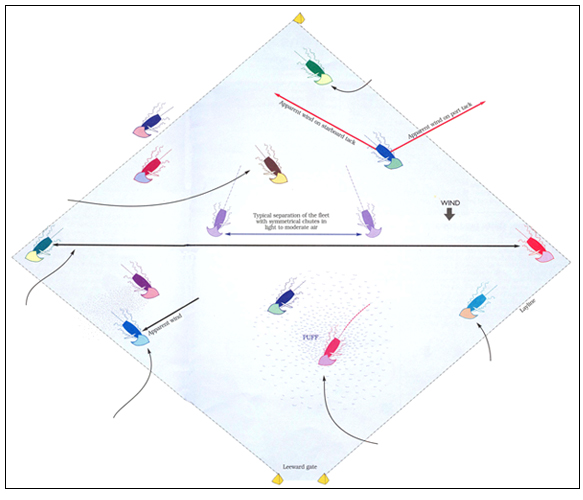|
Smart Moves for Asymmetricals
by David Dellenbaugh
When you're sailing a boat that has a symmetrical spinnaker, the biggest gains and losses usually occur on the upwind legs. But with asymmetricals, it's exactly the opposite. Gains and losses on the beats are relatively small-but on the runs they can be huge!
There are two main reasons for this. First, boats with asymmetrical chutes sail much higher angles downwind, which means they are normally split very far apart on runs. With this much separation, even the smallest shifts or puffs can make a big difference.
The second reason is that asymmetrical boats tend to have a much wider range of performance. It's not uncommon for one boat to sail a knot or two faster, or 10 degrees higher or lower than another boat. This produces large disparities in downwind performance. 
Because of the potential for big gains and losses, it is important to sail fast and smart on runs. Here are a couple of the most important points:
- Jibe back through puffs - Symmetrical boats sail low angles that allow them to head in almost the same direction that a puff is going and therefore stay in a puff longer. Because asymmetrical boats sail higher angles, they tend to go across and out of puffs. To stay in better pressure longer, jibe when you get to the far side of the puff so you can sail back through it.
- Play most shifts as persistent - On runs, asymmetrical boats sail fast with the wind so they don't experience as many shifts. In fact, even if the wind direction is oscillating, they might see only one shift during the course of a 10-minute run. Therefore, they should play that as a persistent shift.
Watch other boats. One thing that's fun about asymmetrical boats is you have a wide range of angles and speeds to choose from. But this can also make it tough to find the downwind groove. Besides your sense of feel, the best guide is your performance relative to other boats. Keep a close eye on whether you are gaining or losing and, if necessary, adjust the way you are sailing your boat.
Pick your passing lane. When you're sailing in a mixed fleet, it's not normally a great idea to pass very close to leeward of a boat with a symmetrical spinnaker. Since they are probably sailing a lower angle, you could get stuck in their wind shadow. To avoid this, look ahead and jibe or pass to windward.
Wow, look at all that separation! Boats with asymmetrical chutes sail higher angles downwind and, in light to moderate air, often get further apart on the runs than they do on beats. This means even the smallest wind shifts or changes in wind velocity can produce huge gains and losses. That's great when you are behind, but if you're ahead be careful about letting the boats behind sail too far away from you.
Keep your air clear. Remember that clear air comes to you from the direction of your apparent wind. Asymmetrical boats sail relatively high and fast, so their apparent wind is usually pretty far forward. This makes it easier for the leeward, leading boat to keep her air clear in front of the trailing boat, It also means that it's harder for the boat behind to affect a leeward boat with her wind shadow (because she has to get so far forward).
Don't jibe too much. In many situations, boats with symmetrical chutes barely slow at all when they jibe. Asymmetrical boats go faster to begin with and have to make a bigger turn, so jibing is more of a disruption and more costly. This means you can't jibe for every little tactical or strategic reason. Prioritize your need to jibe (such as doing a jibe set to go left), and don't jibe without a pretty good reason. If you are planning a jibe set, be sure to approach and round the windward mark with lots of speed.
Evaluate your wind choices. When you're sailing downwind, you can either be on starboard tack or port tack. In both cases, the wind you get (i.e. the puffs, lulls and shifts) will come from the direction of your apparent wind. So when you are considering which way to go, look in the two directions shown since that is where your wind will come from on each tack.
Watch out for laylines. Asymmetrical boats are very sensitive to changes in the wind, and their sailing angle varies widely in puffs and shifts. Therefore, it's not a great idea to reach the layline too far from the leeward mark. All you need is a little header or a slight increase in pressure and you could be overstanding the mark by a lot. That would be especially costly in breeze.
Sail for the puffs. Even small changes in wind pressure can make big differences in downwind performance, especially for asymmetrical boats and especially in light-to-moderate air. Therefore, keep a good lookout to windward. On some days the puffs are obvious, but many times the difference between puffs and lulls is a very subtle shade of color or texture on the water. It's hard to look for this in the middle of a race, but it may be the most important thing.
TOP
|